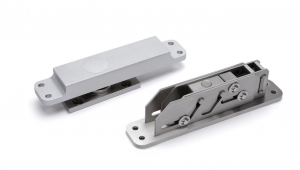A pivot door’s beauty and performance depend entirely on its installation. Even the highest-quality pivot door—paired with top-tier hardware—will fail if installed incorrectly: it may stick, sag, leak, or even become a safety hazard. Unlike traditional hinged doors, which have some flexibility in installation, pivot doors require extreme precision because their rotation relies on a perfectly aligned pivot point. As SMED, a pivot door hinge manufacturer with over 20 years of experience and ISO 9000 certification, I’ve seen firsthand how installation challenges can impact a pivot door’s performance. In this article, I’ll break down the three biggest installation challenges and share solutions to ensure your pivot door works flawlessly for years.
Challenge 1: Alignment and Leveling for Smooth Movement
The most common installation challenge for pivot doors is achieving perfect alignment and leveling—and it’s also the most critical. Pivot doors rotate around a central point, so if the top and bottom pivot points are even slightly misaligned (by as little as 1/8 inch), the door will not rotate smoothly. It may stick, rub against the frame, or even swing open/closed on its own. This misalignment often happens because the floor or ceiling is not level, or because the pivot hinges are installed at an angle. For example, if the floor slopes toward the exterior, the bottom pivot may be lower than the top, causing the door to sag. The solution lies in precision measuring and adjustment: installers should use a laser level to ensure the pivot points are perfectly vertical and level. Our adjustable pivot hinge is designed to address minor misalignments—after installation, installers can tweak the hinge’s position (up/down, left/right) to get the door rotating smoothly.
Challenge 2: Structural Support in Floor and Ceiling
Pivot doors—especially large or heavy ones—put significant stress on the floor and ceiling where the pivot hinges are mounted. Traditional flooring (like hardwood or tile) or drywall ceilings may not be strong enough to support the door’s weight over time, leading to sagging, cracking, or even hinge failure. This is a common oversight: installers may focus on alignment but forget to reinforce the structural support. The solution is pre-installation reinforcement: before mounting the pivot hinges, installers should add structural supports (like metal plates or wooden blocking) to the floor and ceiling. For exterior pivot doors or very heavy panels (200+ lbs), concrete footings or steel beams may be needed. Our pivot door hinge manufacturers team recommends consulting a structural engineer for large pivot door projects to ensure the supports can handle the weight.
Challenge 3: Weatherproofing and Sealing Gaps
For exterior pivot doors, weatherproofing is a major installation challenge. Unlike traditional hinged doors, which have a tight seal along the side hinge and door jamb, pivot doors have a gap around the entire perimeter (since they rotate rather than fit into a jamb). This gap can let in rain, wind, cold air, or insects—leading to energy loss, water damage, or discomfort. Poor weatherproofing often occurs because installers use standard weatherstripping (designed for traditional doors) instead of pivot-specific solutions. The fix involves pivot-specific weatherproofing products: use flexible, compression-style weatherstripping around the door frame that can accommodate the door’s rotation. For the bottom gap, install a threshold with a rubber seal that creates a tight barrier when the door is closed.
Solutions: Skilled Installers, Quality Hardware, Regular Adjustments
While pivot door installation has challenges, they’re easily overcome with the right approach. First, hire skilled installers: look for professionals with experience installing pivot doors, not just traditional ones. Ask for references or examples of past pivot door projects to ensure they understand the precision required. Second, use quality hardware: cheap or generic pivot hinges are more likely to fail or require constant adjustment. Third, perform regular adjustments: even the best installation may need minor tweaks over time (due to temperature changes or settling). Check the door’s rotation every 6 months and use the hinge’s adjustment features to fix any sticking or misalignment. By combining skilled installers, quality hardware, and proactive maintenance, you can avoid installation headaches and enjoy a pivot door that performs perfectly.
Conclusion
Pivot door installation challenges—alignment, structural support, weatherproofing—are real, but they’re not insurmountable. The key is to prioritize precision, use the right tools and hardware, and work with experienced professionals. As a leading pivot door hinge manufacturer with ISO 9000 certification, we offer adjustable pivot hinges, corrosion-resistant options, and detailed installation guides—plus OEM&ODM services to tailor hardware to your project’s needs.
